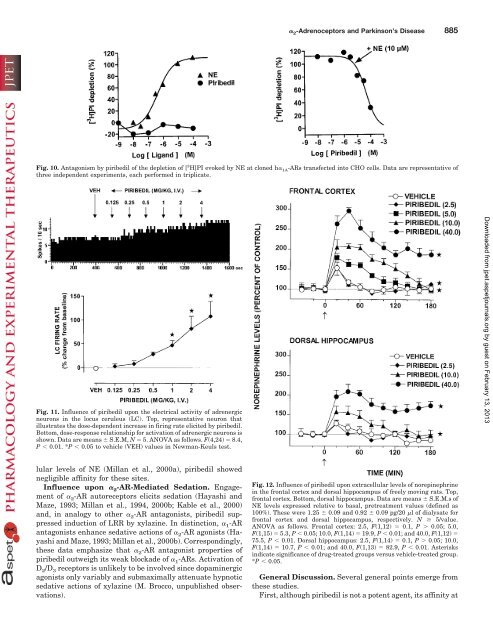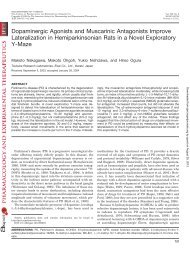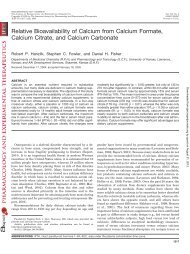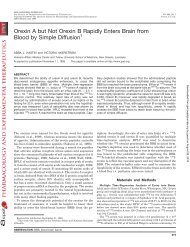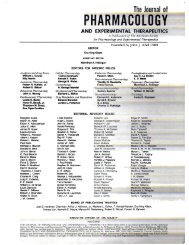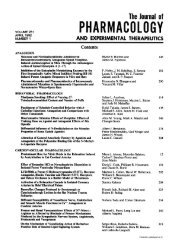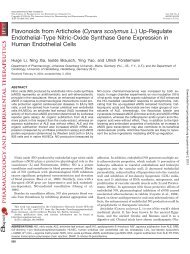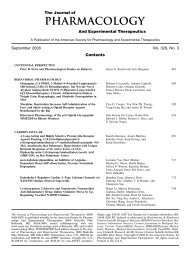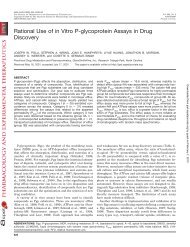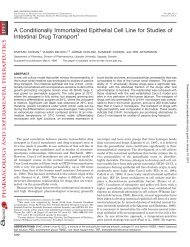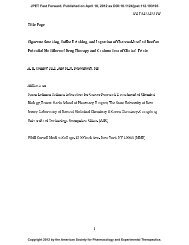Antiparkinsonian Agent Piribedil Displays Antagonist Properties at ...
Antiparkinsonian Agent Piribedil Displays Antagonist Properties at ...
Antiparkinsonian Agent Piribedil Displays Antagonist Properties at ...
You also want an ePaper? Increase the reach of your titles
YUMPU automatically turns print PDFs into web optimized ePapers that Google loves.
Fig. 10. Antagonism by piribedil of the depletion of [ 3 H]PI evoked by NE <strong>at</strong> cloned h� 1A-ARs transfected into CHO cells. D<strong>at</strong>a are represent<strong>at</strong>ive of<br />
three independent experiments, each performed in triplic<strong>at</strong>e.<br />
Fig. 11. Influence of piribedil upon the electrical activity of adrenergic<br />
neurons in the locus ceruleus (LC). Top, represent<strong>at</strong>ive neuron th<strong>at</strong><br />
illustr<strong>at</strong>es the dose-dependent increase in firing r<strong>at</strong>e elicited by piribedil.<br />
Bottom, dose-response rel<strong>at</strong>ionship for activ<strong>at</strong>ion of adrenergic neurons is<br />
shown. D<strong>at</strong>a are means � S.E.M, N � 5. ANOVA as follows. F(4,24) � 8.4,<br />
P � 0.01. *P � 0.05 to vehicle (VEH) values in Newman-Keuls test.<br />
lular levels of NE (Millan et al., 2000a), piribedil showed<br />
negligible affinity for these sites.<br />
Influence upon � 2-AR-Medi<strong>at</strong>ed Sed<strong>at</strong>ion. Engagement<br />
of � 2-AR autoreceptors elicits sed<strong>at</strong>ion (Hayashi and<br />
Maze, 1993; Millan et al., 1994, 2000b; Kable et al., 2000)<br />
and, in analogy to other � 2-AR antagonists, piribedil suppressed<br />
induction of LRR by xylazine. In distinction, � 1-AR<br />
antagonists enhance sed<strong>at</strong>ive actions of � 2-AR agonists (Hayashi<br />
and Maze, 1993; Millan et al., 2000b). Correspondingly,<br />
these d<strong>at</strong>a emphasize th<strong>at</strong> � 2-AR antagonist properties of<br />
piribedil outweigh its weak blockade of � 1-ARs. Activ<strong>at</strong>ion of<br />
D 2/D 3 receptors is unlikely to be involved since dopaminergic<br />
agonists only variably and submaximally <strong>at</strong>tenu<strong>at</strong>e hypnotic<br />
sed<strong>at</strong>ive actions of xylazine (M. Brocco, unpublished observ<strong>at</strong>ions).<br />
� 2-Adrenoceptors and Parkinson’s Disease 885<br />
Fig. 12. Influence of piribedil upon extracellular levels of norepinephrine<br />
in the frontal cortex and dorsal hippocampus of freely moving r<strong>at</strong>s. Top,<br />
frontal cortex. Bottom, dorsal hippocampus. D<strong>at</strong>a are means � S.E.M.s of<br />
NE levels expressed rel<strong>at</strong>ive to basal, pretre<strong>at</strong>ment values (defined as<br />
100%). These were 1.25 � 0.09 and 0.92 � 0.09 pg/20 �l of dialys<strong>at</strong>e for<br />
frontal cortex and dorsal hippocampus, respectively. N � 5/value.<br />
ANOVA as follows. Frontal cortex: 2.5, F(1,12) � 0.1, P � 0.05; 5.0,<br />
F(1,15) � 5.3, P � 0.05; 10.0, F(1,14) � 19.9, P � 0.01; and 40.0, F(1,12) �<br />
75.5, P � 0.01. Dorsal hippocampus: 2.5, F(1,14) � 0.1, P � 0.05; 10.0,<br />
F(1,14) � 10.7, P � 0.01; and 40.0, F(1,13) � 82.9, P � 0.01. Asterisks<br />
indic<strong>at</strong>e significance of drug-tre<strong>at</strong>ed groups versus vehicle-tre<strong>at</strong>ed group.<br />
*P � 0.05.<br />
General Discussion. Several general points emerge from<br />
these studies.<br />
First, although piribedil is not a potent agent, its affinity <strong>at</strong><br />
Downloaded from<br />
jpet.aspetjournals.org by guest on February 13, 2013


